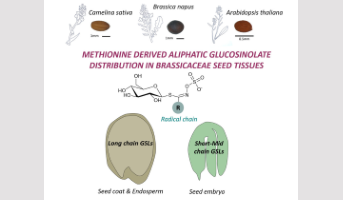From seeds to molecules: diversity and spatial distribution of specialised metabolites in Camelina sativa and other Brassicaceae
specialised metabolites
glucosinolates
seeds
nutrition
Camelina sativa
multiomics
The distribution of glucosinolates in seed tissues depends on their molecular structure – publication by the SEED-DREAM, PHYGERM, and PO-CHEM teams in The Plant Journal
Seeds of camelina (Camelina sativa), an oilseed plant belonging to the Brassicaceae family, represent a major resource for human and animal nutrition as well as for various industrial applications, ranging from biofuel production to green chemistry. Rich in valuable fatty acids, these seeds also accumulate a wide diversity of specialised metabolites, some of which, such as glucosinolates (GSLs), possess beneficial or antinutritional properties. These compounds influence not only the nutritional quality of the seeds but also the plant's defence against pathogens and its adaptation to stress.
While the distribution of specialised metabolites has been studied in the leaves and roots of Brassicaceae species, their spatio-temporal organisation within seeds has remained poorly understood. Gaining insight into how these molecules accumulate and are distributed among different seed tissues is essential for guiding breeding strategies and fully harnessing their potential.
A multi-omic approach, combining untargeted metabolomics, proteomics, and transcriptomics, was employed to analyse the three main seed tissues (seed coat, endosperm, and embryo) of camelina across six developmental stages and two germination stages.
The results revealed contrasting profiles of specialised metabolites, notably GSLs, whose distribution varied according to chemical structure and tissue type. A comparison of GSL composition in the different tissues (seed coat, endosperm, and embryo) of camelina, the model species Arabidopsis thaliana, and the cultivated species Brassica napus (oilseed rape) showed that the distribution of these compounds within the seed is strongly influenced by their molecular structure. In particular, long-chain GSLs (C8–C11) accumulated in the seed coat and endosperm, whereas medium- and short-chain GSLs (C3–C7) were accumulated in the embryo.
Transcriptomic and proteomic data suggested the existence of specific transport mechanisms that account for these differentiated distributions. These findings highlight the key role of structure and transport processes in the accumulation of GSLs.
This study significantly advances the understanding of metabolic dynamics in Brassicaceae seeds and provides a solid foundation for varietal improvement. It opens the way to optimised crops with controlled metabolite partitioning aimed at reducing antinutritional compounds and enhancing high-value molecules of industrial interest.
In the long term, the rational exploitation of the chemical diversity of specialised metabolites will contribute to increase both the nutritional and industrial value of seeds, while addressing the challenges of sustainability and competitiveness in agricultural production chains.
Research developed at the Institute Jean-Pierre Bourgin for Plant Sciences in collaboration.
While the distribution of specialised metabolites has been studied in the leaves and roots of Brassicaceae species, their spatio-temporal organisation within seeds has remained poorly understood. Gaining insight into how these molecules accumulate and are distributed among different seed tissues is essential for guiding breeding strategies and fully harnessing their potential.
A multi-omic approach, combining untargeted metabolomics, proteomics, and transcriptomics, was employed to analyse the three main seed tissues (seed coat, endosperm, and embryo) of camelina across six developmental stages and two germination stages.
The results revealed contrasting profiles of specialised metabolites, notably GSLs, whose distribution varied according to chemical structure and tissue type. A comparison of GSL composition in the different tissues (seed coat, endosperm, and embryo) of camelina, the model species Arabidopsis thaliana, and the cultivated species Brassica napus (oilseed rape) showed that the distribution of these compounds within the seed is strongly influenced by their molecular structure. In particular, long-chain GSLs (C8–C11) accumulated in the seed coat and endosperm, whereas medium- and short-chain GSLs (C3–C7) were accumulated in the embryo.
Transcriptomic and proteomic data suggested the existence of specific transport mechanisms that account for these differentiated distributions. These findings highlight the key role of structure and transport processes in the accumulation of GSLs.
This study significantly advances the understanding of metabolic dynamics in Brassicaceae seeds and provides a solid foundation for varietal improvement. It opens the way to optimised crops with controlled metabolite partitioning aimed at reducing antinutritional compounds and enhancing high-value molecules of industrial interest.
In the long term, the rational exploitation of the chemical diversity of specialised metabolites will contribute to increase both the nutritional and industrial value of seeds, while addressing the challenges of sustainability and competitiveness in agricultural production chains.
Research developed at the Institute Jean-Pierre Bourgin for Plant Sciences in collaboration.
Back

Legend: Distribution of glucosinolates according to their chain length in the three main tissues of Brassicaceae seeds
IJPB Highlight
Reference
Barreda L, Brosse C, Boutet S, Klewko N, De Vos D, Francois T, Collet B, Grain D, Boulard C, Totozafy JC, Bernay B, Perreau F, Lepiniec L, Rajjou L, Corso M. Multi-omic analyses unveil contrasting composition and spatial distribution of specialized metabolites in seeds of Camelina sativa and other Brassicaceae. Plant J. 2025.
https://doi.org/10.1111/tpj.17231
Contact: Massimiliano Corso,contact
IJPB teams
> "Seed - Development, Regulation, and Metabolism" SEED-DREAM team
> "Germination Physiology" PHYGERM team
Platform of the "Plant Observatory"
"The Plant Observatory - Chemistry/Metabolism" plateform PO-Chem
Collaborating team
PROTEOGEN platform, Université de Caen Basse-Normandie, Caen, France
IJPB Highlight
Reference
Barreda L, Brosse C, Boutet S, Klewko N, De Vos D, Francois T, Collet B, Grain D, Boulard C, Totozafy JC, Bernay B, Perreau F, Lepiniec L, Rajjou L, Corso M. Multi-omic analyses unveil contrasting composition and spatial distribution of specialized metabolites in seeds of Camelina sativa and other Brassicaceae. Plant J. 2025.
https://doi.org/10.1111/tpj.17231
Contact: Massimiliano Corso,contact
IJPB teams
> "Seed - Development, Regulation, and Metabolism" SEED-DREAM team
> "Germination Physiology" PHYGERM team
Platform of the "Plant Observatory"
"The Plant Observatory - Chemistry/Metabolism" plateform PO-Chem
Collaborating team
PROTEOGEN platform, Université de Caen Basse-Normandie, Caen, France